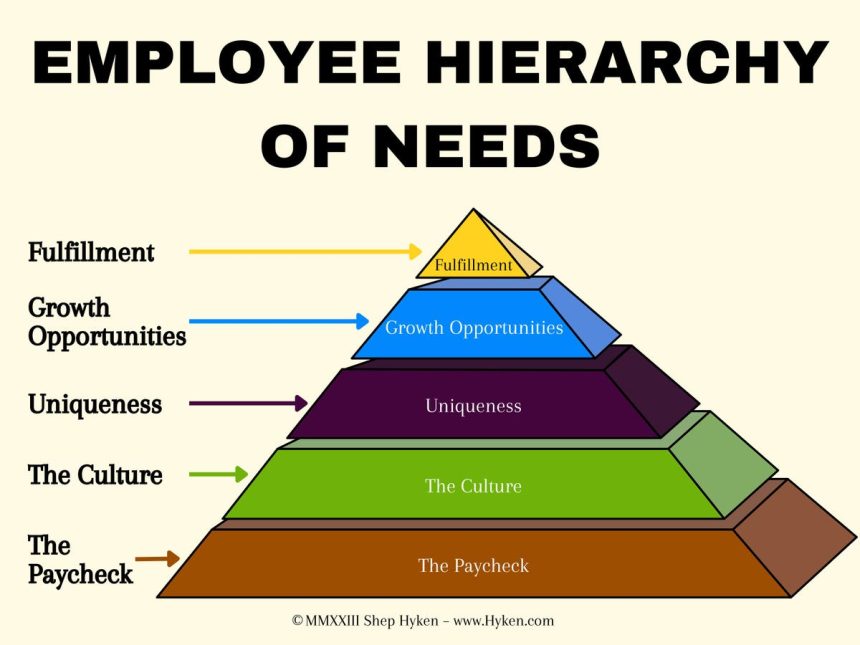Last week, I took creative license with Maslow’s Hierarchy of Needs and shared a version I refer to as The Customer Hierarchy of Needs. When customers buy from a company or brand, their primary need is that whatever they buy works. Moving on, they want to trust the company, align with what they stand for, feel appreciated and ultimately have an emotional connection, which is where customer loyalty is found.
This week, I want to take the concept to the employees of an organization, and so I bring you The Employee Hierarchy of Needs.
First, to have a good customer experience, there must be a good employee experience. And if you want employees to stay, you must find ways to fulfill their needs. For more than 30 years, I’ve emphasized the importance of “internal customer service,” taking care of our colleagues at work the same way we want to take care of our customers—maybe even better. What’s happening inside the organization with employees is going to be felt on the outside by customers. And keeping employees is crucial to the success of a business. The cost of turnover can be overwhelming in the dollars spent to hire, onboard and train a new employee, not to mention the time it takes.
Earlier this year, I wrote how to keep your best employees and featured Joey Coleman’s latest book, Never Lose an Employee Again. Money, as in a bigger paycheck, may not be why people leave, but it is why people work. Simply put, people need a paycheck. That’s a basic need, but the best organizations know they have to do more to keep their best people. And when they do, they reap the benefits of more engaged employees who work harder and feel as if they are part of something special rather than just earning a paycheck.
With all that in mind, I’ve simplified much of my thinking and broken it down into five levels. So, here is The Employee Hierarchy of Needs:
· The Paycheck (and Other Compensation) – As just mentioned, the most basic need is that people need to earn money to pay for their lives: rent, food, clothing, education, etc. Other compensation can include insurance, retirement plans and more. It’s important to keep in mind that compensation is a basic need that can often be found elsewhere. The paycheck is at the base of the employee’s needs.
· Alignment with Beliefs and Vision (The Culture) – Does the culture you’ve created in your organization align with what your employees think is important? There are reasons that some companies have incredibly high turnover while others enjoy very little. Even before a potential employee accepts a job, they research the company and check out Glassdoor.com ratings to get a feel for their potential employer. Disney is known for introducing its culture during the hiring process, potentially weeding out employees (cast members) who won’t be a fit. Employees want to be excited and proud about where they work.
· Growth Opportunities – Most employees want to grow. They want to know there are opportunities to learn new skills, advance their careers and feel more enriched. From the beginning, opportunities should be discussed, and whatever is promised in the hiring process should eventually come to life. When it does, employees are engaged and excited to go to work.
· Uniqueness – This is an often overlooked opportunity. What unique talent does an employee have that they can bring to work? Do they speak another language? Do they have a particular skill that can be incorporated into their responsibilities? I once interviewed a server who had been at the same hotel restaurant for more than 10 years. I asked what kept him there. In addition to enjoying the leadership team and the people he worked with, his manager discovered he was very good at video production. So, once a month, they asked him to create a video showcasing the specials and anything else happening at the restaurant. That they “exploited” his unique talent, even for just a few hours each month, was something he loved most about his job. Take advantage of your employees’ unique talents and find ways they can use them in their jobs, and you will get them closer to the top of the Employee Hierarchy of Needs.
· Fulfillment – At the top of this pyramid model is fulfillment. In The Customer Hierarchy of Needs, emotional connection is the ultimate goal. If you want your best employees to stay, they must love working for you. That means they love their jobs, they love the people they work with and they love their boss. They also feel appreciated for what they bring to the company. When you can do that, combined with their basic need (compensation), a culture they enjoy working in, opportunities to learn and grow and their talents being properly utilized, you are on your way to creating a fulfilled employee, who can turn into a loyal employee.
As mentioned in last week’s “customer version” of this article, I could have written individual chapters in a book on each of these (and I have in some of my books). This article is meant to serve as a primer for deeper conversations within your organization. The concept of fulfilled employees has benefits that permeate through the entire organization and are ultimately felt by customers.
Read the full article here









